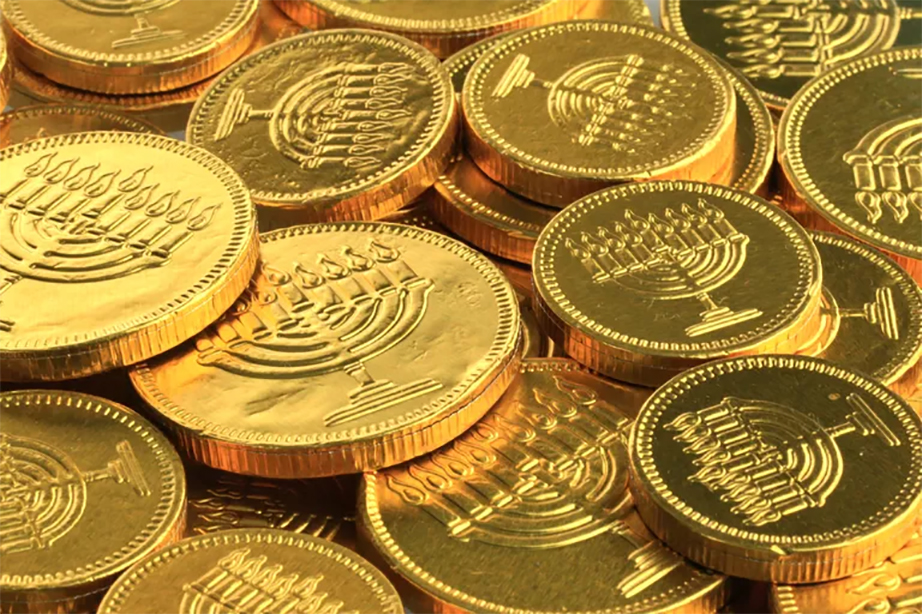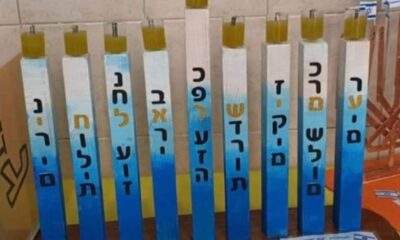
Parshot/Festivals

The gelt in giving and receiving
Published
2 years agoon
“Instead of one day of presents, we have eight crazy nights.” The immortal lyrics of actor/singer-songwriter Adam Sandler may not strictly reflect reality – at least in South Africa – but the ancient tradition of Chanukah gelt (money in Yiddish) is one that many Jewish families follow around the world.
“With Chanukah, the tradition was never about gift-giving,” says Rabbi Ari Kievman of Sandton Central Shul, “that’s more a Christmas tradition, not the Jewish one”. Indeed, the idea of eight nights of presents is something that became increasingly popular in the United States around the 1950s.
“At this time, Jewish child psychologists as well as rabbis started promoting gifts as a way to make post-Holocaust Jewish kids happy to be Jewish rather than sad about missing out on Christmas,” reports www.myjewishlearning.com.
Today, there’s even a (largely American) phenomenon known as “Christmas envy”, reportedly a concern for many Jewish parents who give their children Chanukah presents to counter this.
Though many of our children are hardly lacking, one can certainly choose to give gifts for Chanukah. Yet, if you’re looking to follow authentic Chanukah traditions, it comes back to Chanukah gelt, something mentioned in both the Shulchan Aruch (the Code of Jewish Law) and the Gemara.
It’s also traced back hundreds of years to when students in Europe would give gelt as gifts to their teachers on Chanukah, who couldn’t accept payment for teaching Torah. Eventually, parents began giving their children their own share of the money for studying Torah.
The root of the Hebrew word chinuch (education) is the same as the root of the word Chanukah. Today, gelt isn’t simply about spoiling our kids or grandchildren, it’s about connecting them to an ancient custom and teaching them about the importance of giving back.
While some families simply distribute chocolate coins, others give money. Many give their children progressively more gelt each night in line with lighting more candles and increasingly dispelling darkness. Any amount is acceptable, although you may want the money to add up to a multiple of chai – the Hebrew word for life, which has the numerical value of 18.
This practice can also be used to teach our children the value of money and saving up for something worthwhile.
Teaching kids the value of money is a passion for property sales consultant Laureen Shalpid, who established Fun Finance, a money management course for children aged seven to 11.
She has since written an – as yet unpublished – series of books on the basic principles of saving, spending, and sharing one’s money. Shalpid stresses the need for parents to model financial goal-setting behaviour to their kids.
It offers them a deeper understanding of how they choose to spend their hard-earned funds in a way that reflects their needs and values as people.
“Indulging our kids’ every whim doesn’t create a platform for them to learn healthy financial habits,” she says. “If the goal is to have a financially savvy child that will grow into a financially secure adult, then teaching our children practical money skills from an early age will have a positive impact on their financial development.
“The converse is also true, and therefore the longer we take to reinforce these financials skills in a positive way, the more we allow for negative spending habits to develop in our children.”
Shalpid suggests discussing money with your children openly, teaching them the difference between needs and wants, and opening a savings account for them so they can develop maturity and practical money skills.
Not only can Chanukah gelt be used to teach children financial skills, it can also promote an awareness of the need to give back. “The gelt isn’t just for one’s kids because, as with every Jewish festival, we don’t just take care of ourselves in celebration, we have to be there for others,” says Kievman.
The Talmud itself refers to gelt in that it teaches that you’re not allowed to use the lights of the Chanukah menorah for your own benefit, “even to use the light to count your money”.
“This is very likely a symbol that indicates that people traded money on Chanukah,” says Kievman. He argues that it also goes back to the origins of the dreidel game, now often played together with the gelt.
Dreidel began as a made-up game that kids would play when the Greek soldiers came to do inspections, to hide the fact that they were studying Torah.
“By giving out money and playing the game of dreidel today, we recall how they played dreidel in order to persevere and study Torah in spite of the harsh conditions they were facing.
“It’s part of the tradition of recalling this ‘dedication’ – the English translation of Chanukah – and about teaching kids about the importance of tzedakah.”
Kievman recalls his own cherished childhood growing up in New York, where he and thousands of other kids received double Chanukah gelt from the Lubavitcher Rebbe during his special Chanukah rally. One half was for the kids to enjoy and buy toys or sweets, the other was to give to charity.
“Part of the symbolism of giving one’s children Chanukah gelt is about teaching the importance of the fact that we don’t just celebrate ourselves, we’re not just about indulging in our own enjoyment but also catering for others,” says Kievman.
Shalpid reinforces this idea. “We have to teach our children that no matter how much or how little we might have, there will always be someone who has less than us.
“Helping another fellow human being is our way of showing humility and kindness. They can set aside 10% of the money they might have earned from chores, rewards, or gifts that they received for donation to those less fortunate. Beyond that, it’s important to stress that tzedakah can also come in the form of chesed [acts of kindness], all of which brings our unique divine spark into the world.”
Kievman points to the words of Hillel who says in Pirkei Avot, “‘If I am not for me, who will be for me? But if I am only for myself, what am I?’ You’ve got to take care of yourself, and charity certainly begins at home, but it doesn’t end there. You have to extend it beyond the home.
“Chanukah gelt, which is a luxury, signifies a light beyond the world, you’re giving kids something beyond their basic needs, and there’s something in that too,” says Kievman. “It teaches kids that they have to give back the traditional 10% of their earnings but also enjoy something for themselves, which aligns with Hillel’s idea.”










